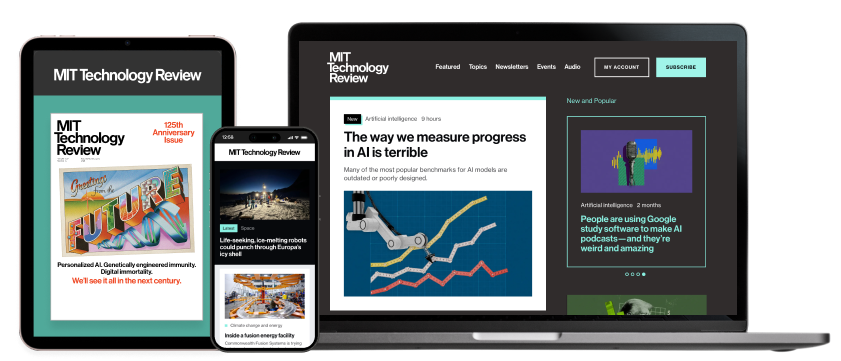THE 2025 LIST


Vera C. Rubin Observatory
A powerful new telescope will come online this year in a remote region of Chile and begin a decade-long survey of the southern sky. Inside is the largest digital camera ever made for astronomy, which will snap photos continuously for years to help astronomers study dark matter, explore the Milky Way, and untangle other cosmic unknowns.
Why it matters
Generative AI search
Generative search promises to make finding what you’re looking for simple and quick. When you type in a query, an AI model summarizes information from many online sources to return a unique answer. On your device, it can comb through documents, photos, and videos, recognizing objects and people to help you find them faster. This may signal the end of traditional search engines and the rise of personal AI assistants.
Why it matters
Small language models
Large language models can do amazing things because they’re crammed with hundreds of billions—even trillions—of parameters (the values that determine their behavior) and were trained on most of the internet’s data. But cheaper and less power-hungry small language models can now stand with the heavyweights across a range of specific tasks. Move over dinosaurs. The future belongs to smaller, nimbler beasts.
Why it matters
Cattle burping remedies
Cow burps are one of the largest sources of agricultural emissions—and one of the trickiest ones to solve. A food supplement that significantly reduces the amount of methane that cattle belch is now available in dozens of countries. Other products, which might prove even more effective, are likely on the way.
Why it matters
Robotaxis
Robotaxis have completed years of beta testing, and they are now finally becoming available to the public. In more than a dozen cities worldwide, riders can summon one whenever they want. Now, the biggest players are ramping up for intense competition as they expand into new cities under regulators’ watchful eyes.
Why it matters




Cleaner jet fuel
New fuels made from used cooking oil, industrial waste, or even gasses in the air could help power planes without fossil fuels. These alternative jet fuels have been in development for years, but now they’re becoming a big business, with factories springing up to produce them and new government mandates requiring their use.
Why it matters
Fast-learning robots
Thanks to today’s generative AI boom, robots are now learning new tasks faster than ever. Today’s automatons are not one-trick ponies—we’re getting closer to general-purpose robots that could be dropped into new environments and tackle a variety of tasks on our behalf, almost instantly.
Why it matters
Long-acting HIV prevention meds
A trial of a new HIV prevention medicine found that 100% of treated women and girls were protected from acquiring HIV infections. And it only needs to be injected once every six months. The drug could help us end AIDS once and for all—if we can ensure access for those who need it.
Why it mattersGreen steel
Making steel is one of the largest industrial sources of carbon dioxide, emitting more carbon than all of India (the world’s third largest emitter) and far more than air travel. The first industrial green-steel plant, which uses hydrogen made with renewable power, is being built by Stegra, a $7 billion startup that is scheduled to begin operations next year in northern Sweden.
Why it matters
Stem-cell therapies that work
Stem cells from human embryos will cure disease. That’s the big promise scientists made decades ago. And now it’s finally coming true. Experimental transplants of lab-made cells seem to be helping treat two very different conditions—epilepsy and type 1 diabetes.
Why it matters


Vote for the
11th breakthrough
What’s missing from the list? Tell us what you think. Cast your vote before April 1, 2025.
Back to top
Thanks for voting!
You voted for . Sign up for our daily newsletter, the Download, and be the first to see the results.
Thank you for submitting your email! Read about some technologies that definitely weren’t breakthroughs:
Something went wrong!
We’re having trouble saving your email. Try refreshing this page and re-entering your email.
10 Breakthrough Technologies
MIT Technology Review’s annual list of 10 Breakthrough Technologies highlights the advances that our newsroom thinks matter most right now. Every year, our team of reporters and editors looks for emerging technologies that have made meaningful progress or passed an important milestone. We compile this list to share the ones that we think are poised to have the greatest impact on our future. This is the 24th year we’ve published this list. Here’s what didn’t make it this time.
Explore the archives
Credits
Editorial
Special projects editor: Amy Nordrum
Editing: Allison Arieff, Rachel Courtland, Niall Firth, Mary Beth Griggs, Mat Honan, Charlotte Jee, Amy Nordrum, David Rotman, Amanda Silverman
Copy editing: Linda Lowenthal, Teresa Elsey
Engagement: Juliet Beauchamp, Abby Ivory-Ganja
Fact checking: Cheryl Alkon, Teresa Elsey, Emma Foehringer Merchant, Cathy Garrard, Jill Langlois, Mike Orcutt
Art
Art direction: Stephanie Arnett, Eric Mongeon
Illustration: María Jesús Contreras, Ari Liloan, Selman Design
Photography: Spencer Lowell
Technology
Lead developer: Andre Vitorio
Design: Vichhika Tep, Mariya Sitnova
Product: Mariya Sitnova, Allison Chase
CTO: Drake Martinet




